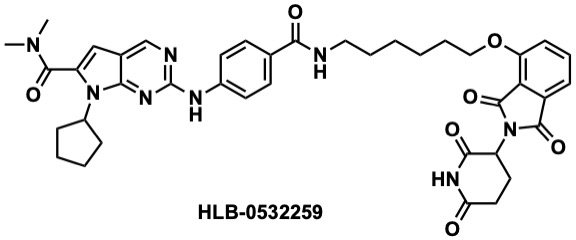Development of HLB-0532259: A First-in-Class Chemical Degrader of Aurora Kinase A and the N-Myc Transcription Factor
N-Myc is a master transcriptional regulator that has been called “undruggable” due to a lack of small molecule binding sites. However, unique molecular vulnerabilities have been identified that provide opportunities for chemical regulation. For example, in neuroblastoma, N-Myc is bound by Aurora kinase A (Aurora-A), which stabilizes N-Myc from proteolytic degradation. Genetic knockdown of Aurora-A in neuroblastoma confers the rapid proteolytic degradation of N-Myc by the ubiquitin proteosome system. Consequently, chemical degradation of Aurora-A provides an opportunity to affect N-Myc levels for oncology applications. Our laboratory has structurally modified the CDK4/6 inhibitor, ribociblib, to afford a high affinity Aurora-A ligand (Kd = 0.89 nM). Elaboration of our Aurora-A ligand into a Proteolytic Targeting Chimera (PROTAC) delivered the novel Aurora-A degrader, HLB-0532259.[1] Extensive biochemical, biophysical, cellular, and in vivo studies have resulted in the characterization of HLB-0532259 as a degrader of Aurora-A (DC50 = 14.4 nM in SK-N-BE(2) neuroblastoma cells) that concomitantly elicits the degradation of N-Myc (DC50, app = 179 nM in SK-N-BE(2) cells). Kinome profiling and tandem mass tag proteomics revealed that HLB-0532259 is highly specific and thereby confers a valuable chemical probe for mechanistic biochemical and cellular studies. In addition, HLB-0532259 possesses reasonable pharmacokinetic properties in mice (t1/2 = 14.5 h, Cmax = 169 ng/mL, AUC = 1993 ng·h/mL, and MRT = 16.1 h) and elicits tumor reduction in vivo in a murine xenograft model. Taken together, HLB-0532259 is a promising lead compound that is being further optimized in our laboratory for potency and physiochemical properties with an eye towards future clinical development. This presentation will highlight our development of HLB-0532259 and related analogues.
